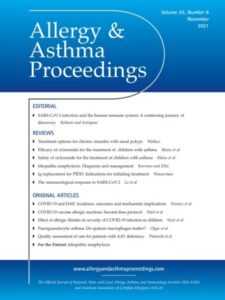
Photo from archive.org
BACKGROUND Local allergic rhinitis (LAR) is rhinitis with a localized nasal allergic response in the absence of systemic allergy. This study aimed to evaluate the pathogenesis specific to LAR compared… Click to show full abstract
BACKGROUND Local allergic rhinitis (LAR) is rhinitis with a localized nasal allergic response in the absence of systemic allergy. This study aimed to evaluate the pathogenesis specific to LAR compared with allergic rhinitis (AR) and nonallergic rhinitis (NAR) by using cytokines from polypous tissues. METHODS We recruited 43 patients with AR (n = 15; mean age, 17.4 years), LAR (n = 12; mean age, 15.9 years), and NAR (n = 16; mean age, 15.6 years) who underwent polypectomy. Atopic status was defined as presenting a sufficiently high total immunoglobulin E (IgE) serum concentration and skin-prick test or serum allergen test. Immunoassays were performed by using polyp tissue homogenates to quantify the levels of regulated on activation of normal T cell expressed and secreted (RANTES), tumor necrosis factor (TNF) alpha, interleukin (IL) 5, and sera to assess total IgE and eosinophil cationic protein. RESULTS RANTES levels were higher in patients with LAR than in patients with AR and NAR. There was a significant correlation in the concentration of RANTES between polyp tissue homogenates and serum (R2 = 0.51, p < 0.05). The levels of IL-5, TNF alpha, and interferon gamma also demonstrated positive correlations between polyp tissue homogenates and serum; however, they were not significantly different. CONCLUSION Results of our study indicated that RANTES may play an important role and contribute to allergic reaction in LAR, and RANTES may be related to the pathogenesis of LAR.
Journal Title: Allergy and asthma proceedings
Year Published: 2018
Link to full text (if available)
Share on Social Media: Sign Up to like & get
recommendations!